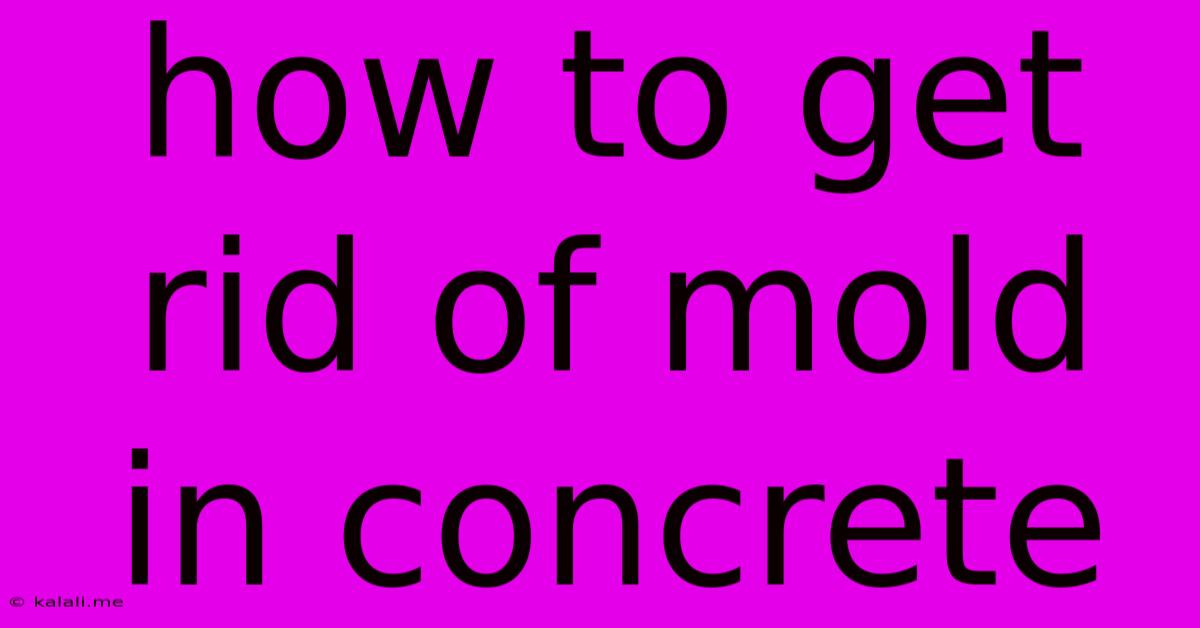How To Get Rid Of Mold In Concrete
Kalali
May 31, 2025 · 3 min read

Table of Contents
How to Get Rid of Mold in Concrete: A Comprehensive Guide
Mold growth on concrete surfaces is a common problem, especially in damp or humid environments. This unsightly and potentially hazardous issue requires prompt and effective action. This guide provides a step-by-step approach to removing mold from concrete, covering prevention strategies and offering solutions for different levels of infestation. Learn how to tackle this problem safely and effectively, restoring the appearance and integrity of your concrete surfaces.
Understanding Mold Growth on Concrete
Before tackling mold removal, it's crucial to understand why it develops. Concrete, being a porous material, can absorb moisture from various sources like leaks, high humidity, or poor drainage. This moisture creates the perfect breeding ground for mold spores, leading to visible colonies that can range from small patches to extensive infestations. Different types of mold can thrive in these environments, some posing greater health risks than others. Identifying the source of moisture is the first critical step in preventing future mold growth.
Assessing the Mold Infestation
The extent of the mold infestation determines the approach you'll need to take. A small, localized patch is much easier to manage than widespread mold coverage. Consider these factors:
- Size of the affected area: Small patches may require localized cleaning, while larger areas might necessitate more extensive remediation.
- Type of mold: While visual identification isn't always precise, knowing if it's black mold ( Stachybotrys chartarum ), which is particularly hazardous, requires professional intervention.
- Porosity of the concrete: Highly porous concrete absorbs moisture more readily and may require more intensive cleaning and potentially sealing.
Removing Mold from Concrete: A Step-by-Step Guide
1. Safety First:
- Protective Gear: Always wear protective gear, including gloves, goggles, and an N95 respirator mask to prevent inhaling mold spores. This is crucial, regardless of the size of the infestation.
- Ventilation: Ensure adequate ventilation in the area by opening windows and doors. Using fans can also help circulate air and remove spores.
2. Preparing the Area:
- Clean the Surface: Remove loose debris and dirt from the affected area using a stiff brush or broom.
- Isolate the Area (if necessary): If the mold infestation is extensive, consider isolating the area with plastic sheeting to prevent spore dispersal.
3. Cleaning the Mold:
- For Small Infestations: A solution of water and bleach (1 cup bleach per gallon of water) is often effective. Apply the solution using a scrub brush, ensuring thorough coverage. Let it sit for 10-15 minutes before scrubbing again and rinsing thoroughly with clean water.
- For Larger Infestations or Black Mold: Professional help is often necessary. Black mold requires specialized cleaning techniques and equipment to prevent further spread and health risks.
4. Drying the Concrete:
- Thorough Drying: Allow the concrete to dry completely after cleaning. This is essential to prevent mold recurrence. Use fans, dehumidifiers, or other drying methods to accelerate the process.
5. Preventing Future Mold Growth:
- Address Moisture Sources: Identify and fix any leaks, drainage problems, or high humidity issues that contributed to the mold growth. Proper ventilation is critical.
- Sealing the Concrete: Applying a sealant to the concrete surface can help prevent future moisture absorption and mold growth. Choose a sealant designed for concrete and follow the manufacturer's instructions.
When to Call a Professional
For extensive mold infestations, particularly those involving black mold, it's best to contact a professional mold remediation service. They have the expertise, equipment, and safety protocols to handle these situations effectively and safely. Don't hesitate to seek professional assistance if you're unsure about tackling the problem yourself.
By following these steps and prioritizing prevention, you can effectively eliminate mold from concrete surfaces and maintain a healthy, mold-free environment. Remember, safety is paramount, and professional help is always an option when dealing with larger or potentially hazardous mold problems.
Latest Posts
Latest Posts
-
Do You Have To Beat Wallace Before Kyogre
Jun 02, 2025
-
Dress Hanging Rod Closet Comes Out From Wall
Jun 02, 2025
-
Bathtub Drain Stopper Stuck In Closed Position
Jun 02, 2025
-
How Old To Go In A Strip Club
Jun 02, 2025
-
What Is The Car Battery Voltage
Jun 02, 2025
Related Post
Thank you for visiting our website which covers about How To Get Rid Of Mold In Concrete . We hope the information provided has been useful to you. Feel free to contact us if you have any questions or need further assistance. See you next time and don't miss to bookmark.